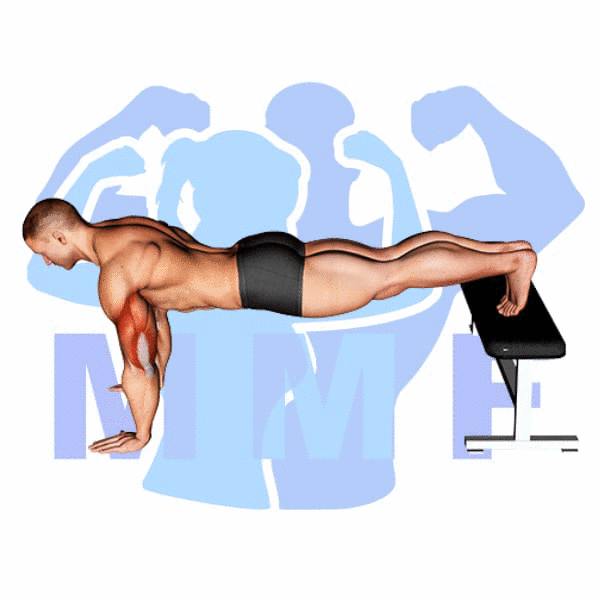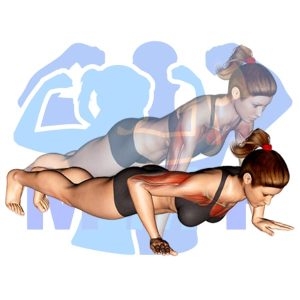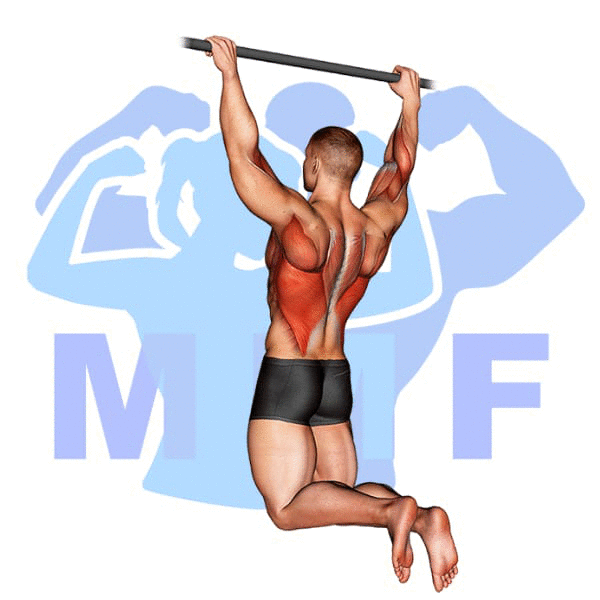Are your regular push-ups not challenging enough anymore? Feeling like you’ve hit a plateau in your workout routine? Don’t worry, it happens to even the most experienced athletes. The good news is, you’re not alone. As you gain strength your body needs new challenges, and that’s where the decline push-up comes in. In this blog post, we’ll explore the benefits of decline push-ups, why you might be doing them wrong, and how to perfect your form for maximum gains. Get ready to take your workout to the next level with this simple yet effective exercise.
Decline Push Up Summary
- Primary Muscles: Pectoralis Major – Sternal
- Secondary Muscles: Deltoid – Anterior, Pectoralis Major – Clavicular, and Triceps Brachii
- Equipment: Flat Bench
- Mechanics Type: Compound
- Force: Push
- Utility: Basic or Auxiliary

Decline Push Up Instructions
- Kneel on the floor with a bench or elevation behind your body.
- Position your hands on the floor slightly wider than shoulder width.
- Place your feet on a bench or elevation.
- Raise your body in a plank position with your body straight, and arms extended.
- Keep your body straight, and lower your upper body to the floor by bending your arms.
- To allow for full descent, pull your head back slightly without arching back.
- Push your body up until your arms are extended.
- Repeat your Decline Push-Up for 8-10 reps.
Video Tutorial
Decline Push Up Muscles
Target (Agonist)
- Pectoralis Major – Sternal
Synergists
- Deltoid – Anterior
- Pectoralis Major – Clavicular
- Triceps Brachii
Dynamic Stabilizers
- Biceps Brachii – Short Head
Stabilizers
- Deltoid – Posterior
- Latissimus Dorsi
- Pectineus
- Pectoralis Major – Sternal
- Rectus Femoris
- Sartorius
- Tensor Fasciae Latae
- Teres Major
- Triceps – Long Head
Antagonist Stabilizers

Benefits of Decline Push Up
The decline push up is an effective exercise for targeting the pectoralis major – sternal muscle. This exercise strengthens the chest and increases muscle mass, as well as increases bone density and improves posture. The decline push up also helps to improve stability and balance in the chest area, as well as strengthening the arms, shoulders and triceps. Performing this exercise regularly will help to improve overall strength and fitness levels, leading to improved performance in sports and other physical activities.
Tips for Performing Decline Push Up
If you’re seeking to take the decline push up to a new level, then you’re at the right place. Using these tips will enable you to maximize the advantages of this effective exercise. You’ll be able to develop your chest muscles, and minimize your chance of getting hurt. Let’s begin and explore how these tips will benefit you.
- Start with your feet elevated on a step or box: This will help make the exercise easier to perform and allow you to build strength gradually and safely.
- Keep your core tight throughout the exercise: This will help you maintain proper form, maximize results, and reduce risk of injury.
- Use a full range of motion: Make sure to lower your chest all the way to the floor and push up until your arms are fully extended. This will ensure that you are engaging all of the muscles in the chest and arms for maximum benefit.
Benefits and Tips Video
Frequent Mistakes To Avoid
When it comes to executing decline push up, avoiding typical errors is usually the difference between an effective workout and a painful injury. Additionally, achieving optimal results from this exercise requires appropriate technique, and avoiding perform typical errors can allow you to perform the exercise correctly and obtain optimal results. But relax, it’s not as challenging as it might seem. By knowing the errors to avert and taking the right actions, you may complete the exercise securely and successfully. Thus, it is now your turn to optimize the impact of this exercise and enjoy the advantages of a successful workout.
- Not maintaining a straight line from head to toe during the exercise: This can cause undue strain on the lower back and shoulders, leading to injury.
- Allowing the head to drop too low during the exercise: This can put too much stress on the neck and shoulders, leading to pain or injury.
- Not using proper form when doing the exercise: Using improper form can reduce the effectiveness of the exercise and increase the risk of injury.
Find More Bodyweight Exercises Here
Variations and Complementary Exercises
Decline Push Ups are an excellent exercise to target your chest and shoulders, but if you’re looking for variations, complementary, or alternative exercises, there are plenty of options to choose from. Here are some exercises that work similar muscles as the Decline Push Up:
Diamond Push Up

The Diamond Push Up is an excellent exercise for strengthening the chest and arms and is a complementary or alternative exercise to the Decline Push Up. The Diamond Push Up requires the same basic movements as the Decline Push Up but with an added challenge. During the Diamond Push Up, the individual’s hands are placed in a diamond shape on the floor while they are in a full plank position. This position puts more strain on the chest and triceps muscles, allowing for increased intensity and an improved workout. Additionally, by adjusting the width of the diamond, the individual can increase or decrease difficulty to suit their individual needs. The Diamond Push Up can be an excellent way to add variety to one’s workout routine or an ideal alternative for those who cannot perform a Decline Push Up.
Incline Push Up

The Incline Push Up is a great complementary or alternative exercise to the Decline Push Up. This exercise is performed by placing your hands on an elevated surface such as a bench, step, or chair and pushing your body up away from the surface. This variation of the push up works the same muscles as the decline push up, but with less stress on the lower body. The incline push up is an excellent exercise for targeting the chest, shoulders, and arms and can be incorporated into any workout routine.
Narrow Push Up

The Narrow Push Up is a great alternative or complementary exercise to the Decline Push Up. Narrow Push Ups focus on the muscles of the chest, shoulders, and triceps in a different way than a Decline Push Up. This exercise requires you to bring your hands in close together as you perform the push up, which recruits more of the chest muscles and makes for a more intense workout. This variation also allows for more range of motion through the arms and shoulders, making it a great choice for those looking to work their upper body in a different way than with a standard Decline Push Up.
Check Out These Top Bodyweight Exercises
Push Up

The Push Up is a bodyweight exercise that is a great complement or alternative to the Decline Push Up. It is performed by placing the hands on the ground, slightly wider than shoulder-width apart, and then pushing up with the arms while maintaining a straight body. The Push Up works the chest, triceps, and core muscles, while also helping to improve posture and balance. It is a great option for those who are unable to perform the Decline Push Up due to lack of equipment or for those who want to challenge themselves with a different form of upper body exercise.
Push Up On Grips

Push Up On Grips is a great complementary or alternative exercise for the Decline Push Up. This exercise helps to increase the challenge of a traditional push up by utilizing specially designed push up grips. It allows you to vary your grip width and angle, which can help to target different muscles for a more effective workout. The height of the grips can also be adjusted, allowing you to increase the intensity of the exercise. This exercise also helps to improve balance and stability, making it an ideal choice for those looking to add variety to their exercise routine.
Push-Ups With Bands

Push-Ups With Bands is a great complementary or alternative exercise for the Decline Push Up. It works the same muscle groups but with an added challenge due to the resistance of the bands. To perform the exercise, wrap a band around your back and grab each end with your hands. Lower yourself into a push up position and then press up against the tension of the band. This exercise is great for building strength, increasing stability, and adding an extra challenge to your workout.
Find More Chest Exercises Here
Opposing Complementary Exercises
In addition to the Decline Push Up exercise, here are some additional exercises that can help you further target the opposite muscle groups and further increase the strength of your upper body:
Band Rear Deltoid Row

The Band Rear Deltoid Row is a great exercise to complement the Decline Push Up. This exercise targets the rear deltoids, which are the opposing muscle group to the chest muscles that are worked during the Decline Push Up. This exercise helps to create a balanced upper body strength by strengthening the muscles on the back of the shoulder. The Band Rear Deltoid Row can also help to improve shoulder stability and posture, making it an excellent addition to any workout routine.
Barbell Rear Delt Raise

The Barbell Rear Delt Raise is an excellent exercise to pair with the Decline Push Up to ensure a well-rounded workout. The Decline Push Up primarily works the chest, triceps, and shoulders, while the Barbell Rear Delt Raise is designed to target the rear deltoids. By pairing these two exercises together, you can effectively work both the anterior and posterior muscles of the shoulder and help build a strong, balanced upper body. Additionally, the Barbell Rear Delt Raise can help improve shoulder stability and increase range of motion in the shoulder joint.
Barbell Skier

Barbell skier is a unique exercise that works the muscles in a way complementary to the decline push up. It targets the core, glutes, and hamstrings while the decline push up targets the chest, triceps, and shoulders. This exercise is great for developing a strong and toned physique since it utilizes opposing muscle groups to create an even balance of strength and muscularity throughout the body. The barbell skier also helps to increase stability and balance while improving coordination and agility.
Take Your Push Up Game to the Next Level with Decline Push Ups!
If you’re looking for the next challenge in your push up routine, it’s time to try out decline push ups! By elevating your feet onto a bench or step, you increase the difficulty and target different muscles in your upper body. This exercise is great for not only building strength and endurance, but also improving your form and stability. Don’t be afraid to give it a try, your muscles will thank you!
References: Wikipedia | ExRx.net | PubMed.gov | Comprehensive List of Chest Bodyweight Exercises




